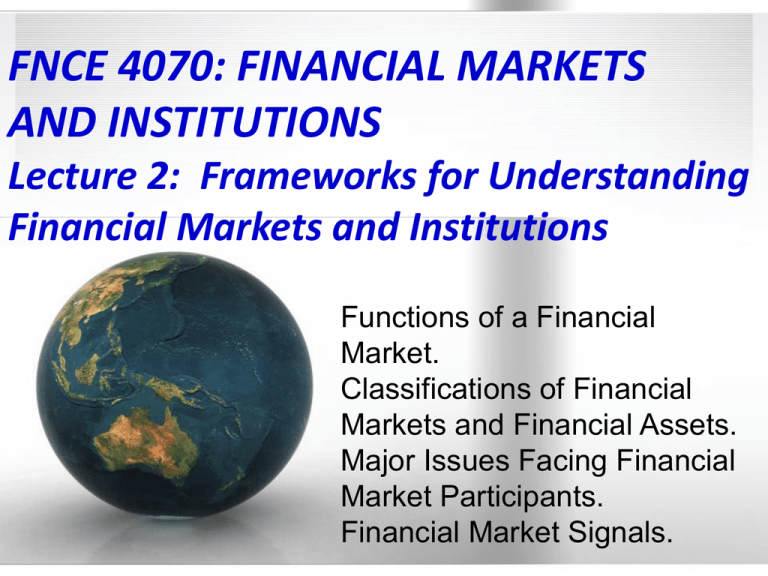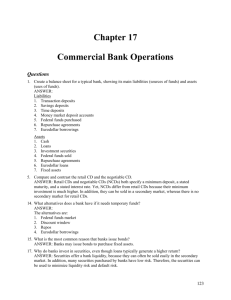Lecture 2: Frameworks for Understanding Financial Markets and
advertisement

FNCE 4070: FINANCIAL MARKETS AND INSTITUTIONS Lecture 2: Frameworks for Understanding Financial Markets and Institutions Functions of a Financial Market. Classifications of Financial Markets and Financial Assets. Major Issues Facing Financial Market Participants. Financial Market Signals. Who are These Central Bankers and Where are their Central Banks? Who are These Central Bankers and Where are Their Central Banks? Federal Reserve (1913) Washington, DC Fed funds rate: 0.0 – 0.25; Inflation target: 2% (2.3%) Ben Bernanke Sir Mervyn King Bank of England (1694) London, U.K. Bank Rate: 0.5%; Inflation target: 2% (3%) Bank of Japan (1882) Tokyo, Japan Uncollateralized Overnight Call Rate: 0 - 0.1%; Inflation Target 1% (0.4%) Masaaki Shirakawa Mario Draghi European Central Bank (1998) Frankfurt, Germany Main Refinancing Rate: 2%; Inflation Target: “Below, but close to 2%” (2.4%) Financial Markets and Financial Institutions How might we study these? Perhaps in terms of specific functions? What are functions of financial markets and financial institutions? Perhaps in terms of organizations and institutions that participate in financial markets Commercial organizations (commercial banks, investment banks, pension funds, mutual funds, financial service providers, etc.). Governmental organizations (Central banks, regulatory organizations --- SEC; FSA) Private credit ratings organizations (S&P, Moody’s, Fitch) Function of Financial Markets Typical text book definition: “Markets through which entities with surplus (“excess”) financial funds transfer those surplus funds to entities who have a shortage (“shortfall”) of available funds.” Stock markets, bond markets, mortgage markets, Treasury securities, commercial paper market. Functions of Financial Markets Mechanism for raising funds! Done in primary financial markets (e.g., IPOs --Facebook) with the assistance of investment banking firms. Mechanism for converting financial assets into cash before maturity. Done in secondary financial markets (e.g., NYSE, OTC bond markets) Functions of Financial Markets Provides the means for entities to protect (hedge) their financial/commercial positions. Done in derivatives markets (options, futures, forwards, credit default swaps) Mechanism for generating a return on surplus funds (Investing). Return occurs through interest, dividends, capital appreciation Functions of Financial Markets Allocates “limited” financial resources among competing users. And, we assume, if done so in the most efficient manner (i.e., to the most productive users): The process will improve economic efficiency and Result in highest possible economic growth! Functions of Financial Markets Provides financial signals to market participants Interest rates, stock prices, exchange rates as measures of market’s perception of risk and changing risk assessments: Stock prices and interest rates may tell us something about the market’s assessment of companies, financial institutions, and even overall financial markets: 2008 credit crisis. Exchange rates and government interest rate spreads may tell us something about the market’s assessment of countries or regions): 2010 – 2012 Crisis in the Euro-zone. Perhaps we can use financial market signals as a leading indicator of economic activity. Yield curves, stock prices, central bank rates Classification of Financial Markets Primary Financial Market The financial market in which new issues of a security, such as a bond or a stock, are sold to initial buyers by a corporation or a government. Important financial institution that assists in the initial sale of securities in the primary market are investment banks. They do this by “underwriting securities,” i.e., (usually) guaranteeing a price for a corporation’s securities and then selling them to the public (an IPO). Thus, primary financial markets are important for raising new capital. Secondary Financial Market The financial market in which securities that have been previously issued can be resold. The New York Stock Exchange (NYSE) and National Association of Securities Dealers Automated Quotation System (NASDAQ) are examples for secondary markets. Secondary markets provide liquidity for previously issued securities: Liquidity refers to the ease of conversion of a financial asset into cash (prior to maturity if there is a maturity date) and how stable the price of the asset is while being held in a form other than cash. Classification of Financial Markets Money Markets The financial markets for short-term debt instruments (generally those with original maturity of one year or less). As we will see, shorter term securities have smaller fluctuations in prices than long-term securities, making them “safer” to invest as well as highly liquid. Commercial banks use Treasury bills for their “secondary reserves” to meet deposit withdrawals and increases in loan demands. Corporations and banks use the money market to earn interest on surplus working capital and to finance working capital shortages. Institutions, such as money market mutual funds, specialize in acquiring these assets. Money market instruments include: U.S Treasury bills, Commercial Paper, Bank Certificates of Deposit, and Bankers’ Acceptances. Capital Markets The financial market for longer-term debt (generally those with maturities greater than one year) and equity (common stock). Long term securities are often held by financial intermediaries such as insurance companies and pension funds, which have less uncertainty about the amount of funds they will need in the future. These assets are also less liquid (in terms of price stability) than money market instruments. Capital market instruments include: Common Stock, U.S Treasury bonds, Corporate bonds, and Mortgages Flow of Funds Through a Financial System Indirect Finance: Funds that flow through financial intermediaries, such as depository institutions, insurance companies and mutual funds. These institutions work as a channel of indirect financing by pooling saver funds then invest (or lending) those funds through to businesses and others that need them. Direct Finance: Funds that flow directly lenders to borrowers with the assistance of institutions that provide brokerage services (research and advice, retirement planning, tax tips, execution of trades) . These institutions work as a channel of direct financing, in which businesses and governments can raise funds directly from lenders in financial markets (IPOs). Flow of Funds Through a Financial System Why are Financial Intermediaries Important in Financial Markets? Transaction cost: Refers to the time and money spent in carrying out financial transactions. Financial intermediaries can substantially reduce transaction costs because they have developed expertise in lowering them, and because their large size allows them to take advantage of economies of scale. Risk sharing: Financial intermediaries sell assets with risk characteristics that people are comfortable with and then use the funds to purchase other assets that may have far more risk. This process of risk sharing is called asset transformation; i.e., risky assets are turned into safer assets for investors. Another way of risk sharing provided was through diversification; financial intermediaries invest in a collection of assets whose return do not always move together, with the result that overall risk is lower than for individual assets. Asymmetric information (i.e., where one party has more or better information): Financial intermediaries are usually better at credit risk screening than individuals, therefore reducing losses due to wrong investment decision making. They have developed expertise in monitoring the parties they lend to, thus reducing losses due to moral hazard. Moral hazard: The tendency to take on more risk because of the perception that one is protected from the consequences of doing so. Classification of Financial Assets (1) Financial assets which represent a claim on the issuer’s future income and/or assets. Examples include: Bonds: Debt instruments with a contractual agreement (indenture specifies interest payment, maturity date, etc.). Common Stocks: Instruments representing an ownership position in a corporation (note this does not represent a “legal” claim such as a bond). (2) Instruments which are neither debt nor equity based and thus belong in their own category. Foreign Exchange Classifications of Financial Assets Cash instruments are financial assets whose value is determined directly by financial markets. Stock and bonds Derivative instruments are financial assets which derive their value from some other (underlying) financial instrument (i.e., called the underlying asset) or variable. Futures, forwards, options (puts and calls) This market originated in Chicago in the 1850s (CBOT) for commodities (flour, hay, corn), but now involves financial assets as well. Characteristics of a Well Functioning Financial Market (1) Transparency: Condition whereby all participants will have access to reliable and important information at the same time. Importance of financial services providers to transparency in disseminating financial information. Dow Jones, Bloomberg, Reuters. Importance of reliable accounting data. Importance of trading platforms to transparency. How quickly is trading information made available? Do all potential traders have access to same trading information (bid and ask prices publicly displayed). Well Functioning Financial Market (2) Adequate Regulation: Financial markets need to have regulation which ensures a level and fair playing field and appropriate behavior. Regulation needs to: Issue for regulators: Encourage quick and full disclosure Provide appropriate reporting of financial information to markets Discourage unethical behavior: insider trading, price manipulations. A what point does regulation become a burden (excessive) and/or drive financial service providers to other markets? Perhaps regulators need to use a cost – benefit analysis approach. Beginning with the Great Depression of the 1930s, the U.S. has gone through a series of financial market regulatory changes. Real GDP and Inflation During the Great Depression Real GDP (1929 = 100) CPI, % Change, YonY The Unemployment Rate and Bank Failures During the Great Depression U.S. Unemployment Rate Number of Banks (1,000’s) U.S. Financial Market Regulation: the Aftermath of the Great Depression The Policy Responses to the Great Depression Over 10,000 banks failed during the Great Depression which began in October 1929 and continuing until March 1933. Government policy makers believed the collapse of the financial system contributed to the length and depth of the recession. In February 1932, Congress passed the Banking Act of 1932. Senator Carter Glass and Representative Henry Steagall coauthored the legislation, which became known as the Glass-Steagall Act. The Glass-Steagall Act contained several provisions which shaped the financial landscape in the United States for about 50 years. (1) The act established nationwide deposit insurance. (2) The act separated commercial from investment banking. The act required commercial banks to sell their securities affiliates within one year. (3) The Act prohibited banks from paying interest on demand deposits. U.S. Financial Market Regulation: In the 1930s Another series of acts in response to the Great Depression regulated stock exchanges and securities markets. In 1933, Congress passed the Securities Act, which established federal regulation of securities issues. In 1934, Congress passed the Securities Exchange Act which established the Securities and Exchange Commission (SEC) to regulate the issuance, purchase, and sale of securities, particularly equities and debt instruments. The act required all public companies to submit periodic financial statements under penalty of perjury. Securities and Exchange Act of 1934 also made it unlawful for any person "to use or employ, in connection with the purchase or sale of any security… any manipulative or deceptive device” (including insider trading). In 1936, Congress passed the Commodities Exchange Act which required all commodities futures and options to be traded on organized exchanges. Pressure to Loosen U.S. Financial Market Regulation: 1980s and 1990s Financial markets operated calmly from the 1940s to the early 1980s. However, During the 1980s and 1990s, the structure of financial regulation in the United States changed dramatically. Impetus for change came from three directions. (1) First, free-market thinking increasingly prevailed in policy debates. (2) Second, globalization forced financial institutions in the United States to compete in ever more competitive international markets against institutions operating in more permissive regulatory environments. U.S. institutions incessantly lobbied to loosen regulations and level the playing field. (3) Third, during the 1970s, the S&L industry collapsed. Policy makers felt the S&L failure had resulted, in part, from overregulation, specifically limiting the interest rate (at 6%) which these institutions could offer on their deposit accounts. When interest rates rose above 6% these institutions became insolvent. Shift to Regulation in the 1980s and 1990s Changes in regulations in the 1980s and 1990s tended reduced restrictions on the operations of financial institutions, allowing them to enter new lines of business. Since the Banking Act of 1932, banks were prevented from engaging in “universal banking,” or banking in both commercial and investment industries. The passage of the Gramm-Leach-Bliley Act of 1999 removed the barriers between the banking sectors of commercial, investment, and insurance, effectively overturning the Glass-Steagall Act. Additional acts phased in the paying of interest on checking accounts and eliminated any interest rate ceilings on savings and time deposits. Response to Corporate Abuse: Passage of SOX in 2002 The Public Company Accounting Reform and Investor Protection Act of 2002, more commonly referred to as Sarbanes-Oxley (SOX), was passed in July 2002 after several prominent companies were involved in financial scandals and bankruptcies: Enron, Worldcom, Xerox, Sunbeam, Waste Management, Adelphia, Tyco, HealthSouth, Global Crossing, and others” SOX contains three main components. First, in an attempt to provide market participants with access to identical information and a level playing field, SOX “forbids preferential disclosures to market analysts.” Second, in an attempt to create accountability and monitoring within corporations, SOX requires the CEO and CFO of all publicly traded corporations to sign the financial statements that they submit to the SEC, opening them up to criminal penalties for perjury should the forms prove fraudulent. In addition, SOX requires publicly traded companies have an independent board of directors. Third, SOX mandated “more monitoring by accountants, in addition to monitoring by independent directors. Response to 2007-09 Financial Crisis: Passage: Dodd-Frank in 2010 The Dodd-Frank Wall Street Reform and Consumer Protection Act, commonly known as Dodd-Frank, is comprised of several unrelated regulations. The Act passed in July 2010 in response to the 2007 – 2009 financial crisis. One prominent aspect of Dodd-Frank is the Volcker Rule (named after the former Federal Reserve chairman who proposed it). While it is still in the discussion stage, the essential elements are as follows: The Volcker rule is an attempt to separate investment banking, private equity and proprietary trading (hedge fund) sections of financial institutions from their consumer lending arms. The Volcker rule would restrict the ability of banks whose deposits are federally insured from trading for their own benefit by prohibiting an insured depository institution and its affiliates from: engaging in “proprietary trading”; acquiring or retaining any equity, partnership, or other ownership interest in a hedge fund or private equity fund; and sponsoring a hedge fund or a private equity fund. The Volcker rule would ban banks from making speculative bets with firm money, but includes an exemption for trades done to hedge risk. In essence, the rule would return some restrictions on proprietary trading by commercial banks that were lifted when the Glass-Steagall Act was rescinded. Well Functioning Financial Market (3) Competition: Markets need to be structured and regulated so as to offer easy access and exit. Not segmenting financial service providers. Not overly protecting (or rescuing) poorly run firms. Moral hazard issue (“too big to fail” or government guarantees). Competition applies to both domestic and foreign entities. Goal: To ensure best prices and services for end users. (4) Market Structure which Allows for Innovation: To provide needed new services and new product development. Allow financial service providers to respond to needs of end users. Development of derivative products in the 1970s through today. Major Issue Facing Participants in Financial Markets Are the prices of financial instruments potentially unstable? How volatile are they? Are they subject to? Quick and large short term moves. Substantial longer term trend changes Quick answer: YES!!! Volatility is one major issue facing participants in financial markets. Interest Rates Annual Data YoY Corporate AAA Total Return Changes in Stock Prices Annual Data YoY Changes in Exchange Rates Annual Data (YoY) Impact of Changes in Financial Variables Changes in interest rates: Affect the cost of borrowing (end users and intermediaries) Influence the returns (and profit margins) to interest sensitive financial institutions (e.g., banks) and the borrowings/investments of non-financial sectors (household and companies). Affect asset prices (bonds, stocks, foreign exchange). Impact on the M&A market (leveraging activities) Impact on mortgage markets. Changes in stock prices: Affect the economy’s perception of wealth: Influence spending decisions (through the “wealth effect”). Affect the IPO market and M&A market (P/E multiples) Changes in exchange rates: Affect the competitive position of global firms, exporters and importers. Affect the returns to global investment funds (mutual funds, pension funds). Signals from the Stock Market Forecasters have noted that for the U.S., investors start discounting the end of an expansion and the beginning of a recovery in advance of the business cycle turning point. Study by Jeremy Siegel: 38 of the 41 U.S. recessions (or 93%) over the period1802 to 1990 have be preceded by an 8% decline in the stock market. The S&P 500 is one of the 10 measures in the Conference Board’s monthly Leading Indicator Index for the U.S. http://www.conferenceboard.org/data/bcicountry.cfm?c id=1 Stock Market as a Leading Indicator: 1968-1983 Stock Market as a Leading Indicator: 1989-1992 Stock Market as a Leading Indicator: 1997-2011 Appendix 1 Useful Websites for Stock Prices and Exchange Rates Stock Prices For long term historical views go to: http://moneycentral.msn.com/investor/charts/ chartdl.aspx?Symbol=%24INDU&CP=0&PT= 5 For a view of what’s happening now go to: http://bloomberg.com/ Or: http://finance.yahoo.com/marketupdate?u Exchange Rates Go to: http://fx.sauder.ubc.ca/ http://www.fxstreet.com/




